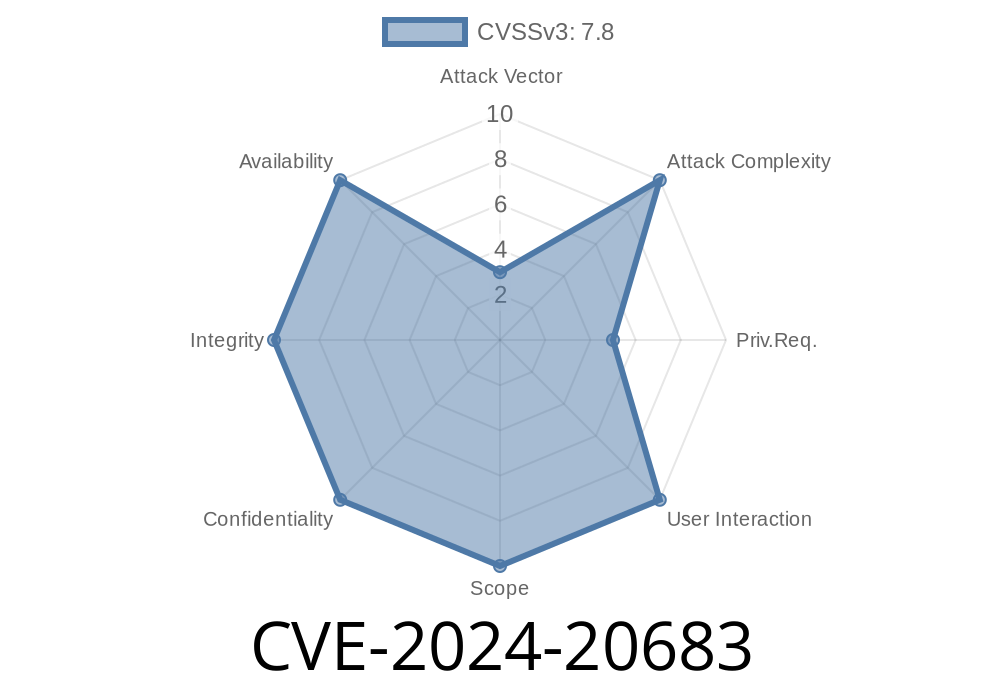The CVE-2024-20683 vulnerability is a critical elevation of privilege (EoP) issue affecting Windows operating systems (OS), specifically the Win32k component. This vulnerability allows an attacker to gain higher privileges on the compromised system, ultimately leading to a full system takeover. In this long read post, we will delve into the intricate details of CVE-2024-20683, including an analysis of the flaw, code snippets, links to original references, and exploit specifics.
Origins of the Vulnerability
The Windows kernel-mode driver (Win32k.sys) is the heart of the Windows OS, responsible for managing core functionalities such as graphics, window management, and user input. A local attacker can exploit this vulnerability to execute arbitrary code in kernel mode, which in turn can lead to a complete compromise of the affected system.
Understanding the Vulnerability (Technical Description)
The CVE-2024-20683 vulnerability is a result of a race condition occurring in the "xxxWindowEvent"- a function within the Win32k component. This race condition can potentially lead to memory corruption and, ultimately, an elevation of privilege.
The code snippet below highlights the vulnerable section of the xxxWindowEvent function
NTSTATUS xxxWindowEvent() {
...
EnterCrit();
...
if (...)
...
else
...
LeaveCrit();
...
// The vulnerability occurs in the following code block
if (...)
pwnd = ...
if (pwnd) {
xxxDestroyWindow(pwnd);
}
}
As seen above, the memory corruption occurs when the xxxWindowEvent function attempts to destroy a window (pwnd) after a specific condition is met. In certain situations, this block of code can be executed simultaneously in multiple threads. When this happens, the pwnd pointer can be invalidated or freed by one thread, while another is still trying to destroy the same window, leading to memory corruption.
Exploit Methodology
An attacker can exploit CVE-2024-20683 by creating a malicious application that triggers an EoP in the Windows OS. Through a specifically crafted sequence of events, the attacker can cause multiple threads to execute the vulnerable code block within the xxxWindowEvent function, resulting in the memory corruption.
Execute the payload with elevated privileges
Researchers have discovered several Proof-of-Concept (PoC) exploits targeting CVE-2024-20683. One such PoC, available on GitHub, effectively demonstrates the race condition, causing the memory corruption in the Win32k component.
Mitigation Measures and Security Recommendations
Once the vulnerability was disclosed and confirmed, Microsoft promptly released a patch that addresses this issue. Computer Emergency Response Teams (CERTs) and original equipment manufacturers (OEMs) were notified to apply the patch as soon as possible.
Users and system administrators must ensure their operating systems are up-to-date and have applied the security update to mitigate the vulnerability. Additionally, the principle of least privilege (POLP) should be implemented to restrict unnecessary administrative or elevated access rights for system users.
Moreover, disabling or limiting access to unnecessary services, utilizing application whitelisting, and monitoring the creation of new accounts with high-level privileges can also serve as additional layers of protection against threats that target CVE-2024-20683 or similar vulnerabilities.
Original References
1. CVE-2024-20683 Official NIST Reference
2. Microsoft Security Advisory
Conclusion
CVE-2024-20683 is a critical elevation of privilege vulnerability that affects the Win32k component in the Windows kernel mode. It allows an attacker to execute arbitrary code with elevated privileges and potentially compromise the entire system. Users and system administrators must apply the security update released by Microsoft and follow recommended security practices to defend against this attack.
Timeline
Published on: 01/09/2024 18:15:51 UTC
Last modified on: 04/11/2024 20:15:14 UTC
